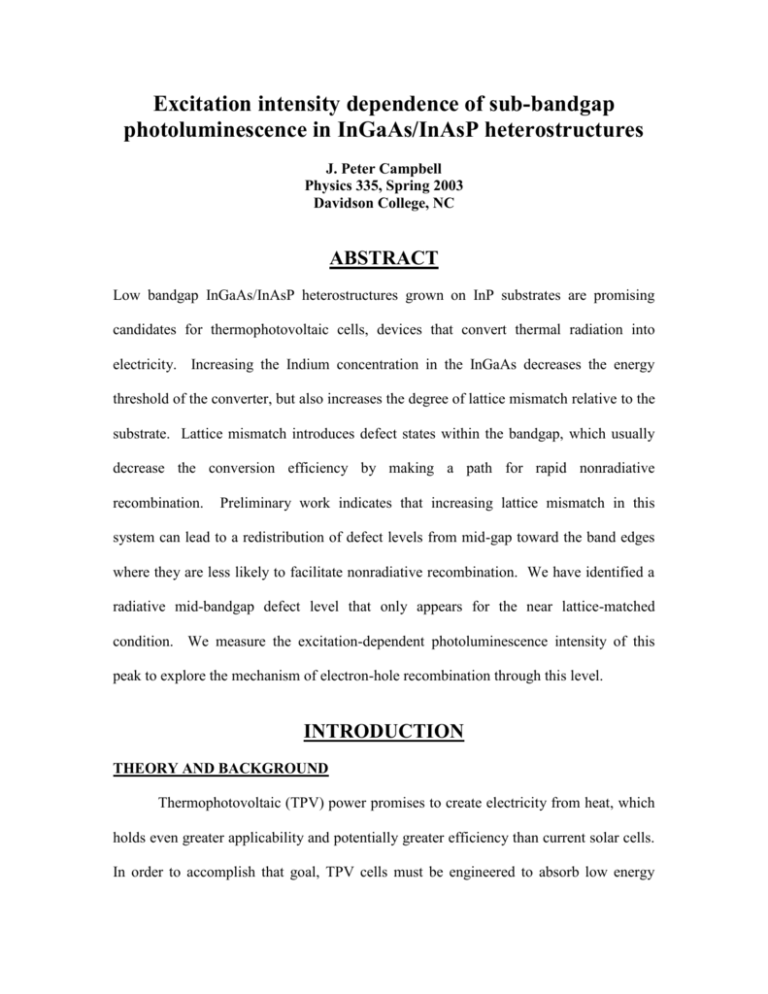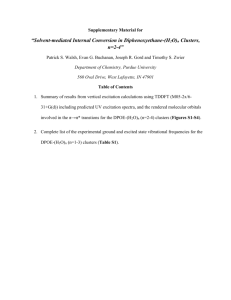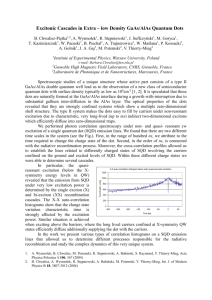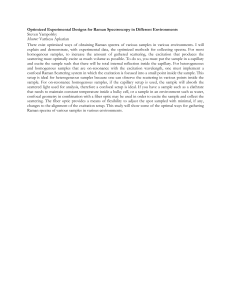Excitation intensity dependence of sub-bandgap
advertisement

Excitation intensity dependence of sub-bandgap photoluminescence in InGaAs/InAsP heterostructures J. Peter Campbell Physics 335, Spring 2003 Davidson College, NC ABSTRACT Low bandgap InGaAs/InAsP heterostructures grown on InP substrates are promising candidates for thermophotovoltaic cells, devices that convert thermal radiation into electricity. Increasing the Indium concentration in the InGaAs decreases the energy threshold of the converter, but also increases the degree of lattice mismatch relative to the substrate. Lattice mismatch introduces defect states within the bandgap, which usually decrease the conversion efficiency by making a path for rapid nonradiative recombination. Preliminary work indicates that increasing lattice mismatch in this system can lead to a redistribution of defect levels from mid-gap toward the band edges where they are less likely to facilitate nonradiative recombination. We have identified a radiative mid-bandgap defect level that only appears for the near lattice-matched condition. We measure the excitation-dependent photoluminescence intensity of this peak to explore the mechanism of electron-hole recombination through this level. INTRODUCTION THEORY AND BACKGROUND Thermophotovoltaic (TPV) power promises to create electricity from heat, which holds even greater applicability and potentially greater efficiency than current solar cells. In order to accomplish that goal, TPV cells must be engineered to absorb low energy (infrared) light. As importantly, however, the cells must be able to efficiently convert the energy from incident photons into electricity, which depends on the radiative conversion efficiency. Conversion efficiency relates to the relative probabilities of various electronhole recombination mechanisms, which will be discussed shortly. This work endeavors to augment the development of more efficient TPV cells by exploring the mechanisms of electron-hole recombination in lattice-matched and slightly lattice-mismatched semiconductors. The development of TPV cells using InxGa1-xAs/InAsP heterostructures on InP substrates shows great promise in engineering low bandgap cells. Increasing the Indium concentration relative to the Gallium in the active layer lowers the bandgap energy of the semiconductor. The two samples utilized in this work have x = .47 and x = .40, which corresponds to bandgap energies of .80 and .73 eV, respectively at 77K (.73 and .65 eV at room temperature). Unfortunately, increasing the Indium concentration in the active layer also increases the mismatch between the lattice constant for the active layer of InGaAs and the substrate of InP. This mismatch induces defect states within the bandgap (which theoretically should be free of energy levels). These defect states facilitate non-radiative recombination, which decreases the conversion efficiency of the cell by allowing a quick electron-hole recombination pathway. The probability (and kinetics) of defect-related recombination is inversely related the energy gap between states. Thus, the fewer defect states that exist within the bandgap, the less likely (and slower) is defect-related recombination. There are two important mechanisms of electron hole recombination at 77K, radiative and nonradiative, or defect-related. Radiative recombination occurs when an electron gets excited to the conduction band and then recombines with a hole from the valence band by emitting a photon. The kinetics of this reaction process is dependent on two “particles,” since both the electron and the hole must be in the same geographic region at the same time for this process to occur. This is the preferred mechanism for TPV cells because the greater this mechanism is favored over nonradiative processes, the more likely it is that the excited electron will be utilized to create electricity under an induced voltage, rather than recombining without creating a current in the cell. Defect-related recombination occurs when the electron is able to recombine with a corresponding hole by emitting phonons, which are units of heat. When the energy gap is small, the electron may be able to fall from the conduction band into successively lower energy states until it finally recombines with the hole. The probability of this mechanism decreases with increasing bandgap due to the fact that the energy emitted in the form of a phonon must be able to be absorbed by the lattice. Especially at low temperatures, the lattice is very unlikely to be able to absorb a phonon on the order of the bandgap energy. Previous work suggests that lattice-mismatched samples contain defect levels within the bandgap, but the distribution of those states changes with increasing mismatchi. Specifically, as the mismatch increases, the density of defect states is redistributed from the center of the bandgap towards the edge, where the states are less likely to facilitate nonradiative recombination. Though most of these states will probably be nonradiative, spectroscopic investigation of the bandgap region might shed further light on this phenomenon.ii This work was begun in June 2002. Photoluminescence (PL) investigation revealed a sub-bandgap (SBG) luminescence peak approximately 200 meV below the band-to-band (BB) PL peak, which disappears as lattice-mismatch increases.iii It was observed in the lattice matched (x = .47) and slightly lattice-mismatched (x = .40), but not in the more mismatched samples. This could confirm the hypothesis that the deep mid-gap peaks decrease with increasing mismatch, but it offers no confirmation of the near BB defect states that are hypothesized to arise in the mismatched samples. This peak was found to have an activation energy on the order of 25-30 meV. Since this energy is on the order of the characteristic phonon energies for this sample, it is hypothesized that nonradiative recombination out of this state is thermally activated.iv Further work must be done to better understand the mechanism of electron-hole recombination through this peak. PHY 335 FINAL PROJECT This work was motivated by the discovery of a radiative SBG peak 200 meV below the BB transition in the lattice-matched and slightly lattice-mismatched samples. Further characterization of this peak was deemed necessary in order that the mechanism(s) of recombination through it might be better understood, and the previous work might be corroborated or challenged. We decided to explore the excitation-intensity dependence of this peak for two reasons. First, the intensity (area under the spectral peak) of the PL as a function of excitation intensity ought to saturate above a certain carrier density (number of electrons per unit cm3).v Previous work with radiative efficiency measurements suggests that “defect-related transitions are negligible relative to BB recombination when [excitation power density exceeds] 10 W/cm2.”vi This saturation at high excitation power density was not observed last summer. Second, changes in the shape of the PL spectra as a function of increasing excitation power might illuminate other characteristics of the sample. MATERIALS AND METHODS The experiment consisted simply of viewing the PL spectra for two different semiconductor samples over a range of excitation intensities. We used a Nd/Yag laser at 1064 nm, which was attenuated with ND filters to vary the intensity of the light incident on the sample in the cryostat, which was focused to varying spot sizes to adjust the excitation power density. The sample was contained in a variable-temperature static exchange-gas cryostat, cooled to 77K with liquid nitrogen. The photoluminescence was collected with a CaF2 lens and analyzed with a MIR8000 Fourier Transform Infrared Spectrometer (FTIR), fitted with a HgCdZnTe detector, which responds between 1 and 6 um. Figure 2 displays the experimental setup. The lens with which the incident light was focused on to the sample was utilized to vary the spot size on the sample. Varying the spot size allowed us to adjust the excitation power density from approximately 22285 W/cm^2. Experimental Setup Nd/Yag Laser (1064 nm) Cryostat @ 77K MIR 8000 Sample FTIR ND Filters : Laser Light : Luminescence Figure 1. Experimental setup for photoluminesce analysis of excitation-intensity dependent sub-bandgap photoluminescence. Data acquisition was rather straightforward. All data were obtained at 77K. For each spot size, ranging from 2.80 x 10-4 cm2 to 2.07 x 10-2 cm2, spectra were obtained over the available range of excitation intensities.vii The lower limit was caused by signalto-noise interference with data collection, whereas the maximum laser intensity provided the upper limit.viii The FTIR was set to 16 cm-1 resolution and most of the spectra were averaged from 1000 measurements.ix Before every set of spectra, I optimized all of the adjustable parameters to maximize the BB PL peak. Data analysis was much more complicated. Each spectrum for each sample was plotted in Excel against the other spectra from that sample (of varying excitation power densities), as well as against the similar excitation power density spectrum from the other sample. These were visually compared and characterized before any other analysis was performed, so that if more spectra were needed they could easily be obtained (before the sample warmed up to room temperature). Once all spectra had been obtained, they were transferred to Origin 6.1 with which several quantitative comparisons were performed. First, the relative intensities of the SBG peak and the BB peak were obtained by calculating the ratio of the two integrated spectral peaks. These ratios were plotted as a function of increasing excitation power density (excitation intensity divided by spot size) to observe whether saturation of the SBG PL would occur above a certain excitation power density. The ratio of the SBG to BB heights was also obtained from the integral measurement and plotted in the same fashion. The same analysis was performed again where instead of using the actual spectral peaks for the integral and height calculations, those measurements were made on a Gaussian function fit to the spectra. With the Gaussian fit, it was also possible to measure the ratio of the peak widths, as well as the heights and areas (intensities). These measurements were mostly useless due to poor fits for the spectral peaks. Especially with the BB PL spectra, the near band-edge impurities make a Gaussian fit unreliable. These data are included in the lab manual, but not in this paper. RESULTS The first part of the experiment consisted of obtaining spectra for each sample across a wide excitation range. Figures 2,3 display the spectra for the lattice-matched (LM) and slightly lattice-mismatched (SLMM) samples, respectively, at 22 W/cm2 and 2285 W/cm2. There are several spectral characteristics that are significant. First, though the intensity of the excitation changes by two orders of magnitude, the SBG PL peak intensity (measured by the height of the curve) remains relatively constant. The shape of the spectral peak changes at higher excitation power (P-ex), however, with significant fluorescence from the higher-energy tail of the characteristic SBG peak. This additional fluorescence begs further investigation than could be performed in this analysis. LM PL Spectra vs. P-ex PL Intensity (a.u.) 1.00E+00 LM x 22 W/cm^2 1.00E-01 LM x 2285 W/cm^2 1.00E-02 1.00E-03 1.00E-04 1.00E-05 0.40 0.50 0.60 0.70 0.80 0.90 Energy (eV) Figure 2. This graph plots the PL spectra for the lattice-matched (LM) sample for two different excitation powers. Notice the significant change in the spectral shape between the two excitation powers. SLMM PL Spectra vs. P-ex PL Intensity (a.u.) 1.00E+00 1.00E-01 SLMM x 22 W/cm^2 1.00E-02 SLMM x 2285 W/cm^2 1.00E-03 1.00E-04 1.00E-05 1.00E-06 0.40 0.50 0.60 0.70 0.80 0.90 Energy (eV) Figure 3. This graph plots the PL spectra for the slightly latticemismatched (SLMM) sample for two different excitation powers. Notice the significant change in the spectral shape between the two excitation powers. Also notice the significant falling laser-edge tail at the higher power. Once the spectra for each sample were compared as a function of increasing excitation power, I compared them with each other for three different intensities. Figures 4,5,6 display the spectra for both LM and SLMM for 3, 22, and 2285 W/cm 2, respectively. The first observable difference is that the SLMM sample clearly displays a lower bandgap than the LM sample, as would be expected due to its higher indium concentration. The second observation for the constant excitation spectra relates to the relative intensities of the SBG PL for each sample. At 3 W/cm2, the SLMM SBG PL is significantly less intense than for the LM SBG PL. This result is in agreement with that reported in Campbell and Gfroerer. However, at 22 W/cm2 and 2285 W/cm2, the intensities of the two SBG PL peaks are not significantly different. Thus, the intensity of the SLMM SBG PL is increasing at a faster rate than the LM SBG PL. PL Spectra at 3 W/cm^2 PL Intensity (a.u.) 1.00E+00 1.00E-01 LM SLMM 1.00E-02 1.00E-03 1.00E-04 1.00E-05 0.40 0.50 0.60 0.70 0.80 0.90 Energy (eV) Figure 4. This graph plots the PL spectra for both samples at 3 W/cm2. At this excitation power, the PL intensity of the SLMM sample is less than that for the LM sample. PL Intensity (a.u.) PL Spectra at 22 W/cm^2 1.00E+00 1.00E-01 LM 1.00E-02 SLMM 1.00E-03 1.00E-04 1.00E-05 0.40 0.50 0.60 0.70 0.80 0.90 Energy (eV) Figure 5. This graph plots the PL spectra for both samples at 22 W/cm2. At this excitation power, the PL intensity of the SLMM sample is slightly greater than that for the LM sample. This challenges the findings cited in Campbell and Gfroerer,2002(unpublished). PL Spectra at 2285 W/cm^2 PL Intensity (a.u.) 1.00E+00 LM 1.00E-01 SLMM 1.00E-02 1.00E-03 1.00E-04 1.00E-05 0.40 0.50 0.60 0.70 0.80 0.90 Energy (eV) Figure 6. This graph plots the PL spectra for both samples at 2285 W/cm2. At this excitation power, the PL intensities of both samples are about the same. This again challenges the findings cited in Campbell and Gfroerer,2002(unpublished), though it is at a much greater excitation power density. Once the spectra had visually been compared to each other, the quantitative analysis was performed in Origin 6.1. Figure 7 displays the ratio of SBG: BB PL intensities, as measured by the area under the spectral peaks, as a function of the excitation powers for each spectra. Figure 8 displays the ratio of the SBG: BB PL peak heights, which was calculated automatically when the integral was computed for each peak. SBG:BB PL Intensity SBG:BB PL Intensity vs. P-ex 8.0E-03 LM 7.0E-03 SLMM 6.0E-03 5.0E-03 4.0E-03 3.0E-03 0 5 10 15 20 25 Excitation Power (W/cm^2) Figure 7. This graph plots the ratio of the sub-band gap to band-to-band peak intensities for both the LM and SLMM samples. Observe the opposite trends for the two samples. SBG:BB Peak Height SBG: BB Peak Height vs. P-ex 3.5E-03 LM SLMM 3.0E-03 2.5E-03 2.0E-03 1.5E-03 1.0E-03 0 5 10 15 20 25 Excitation Power (W/cm^2) Figure 8. This graph plots the ratio of the sub-band gap to band-to-band peak heights for both the LM and SLMM samples. The ratio of the PL intensities displays a marked difference in the relationship between SBG: BB PL as a function of excitation power between the two samples in this range (Figure 7). For the LM sample, the ratio decreases slightly as excitation power increases. The trend line fitting the data estimates a slope of -6.6 (+/- 1.2) x 10-5, with an R2 = .9731. For the SLMM sample, the ratio increases over the same excitation range. The SLMM trend line is 2.2 (+/- 0.4) x 10-4, with R2 = .9677. The ratio of the PL peak heights displays a similar trend (Figure 8). The LM SBG:BB peak height ratio remains relatively constant over this change in excitation power. The trend line estimates a slope of 4.4 (+/- 9.6) x 10-6, with a low R2 = .1691. The SLMM SBG: BB peak height ratio grows. The trend line estimates a slope of 9.1 (+/-1.4) x 10-5. DISCUSSION This work reports several phenomena that are either newly reported, or which challenge previously reported results. First, to this author’s knowledge the relationship between SBG: BB PL intensity vs. excitation power for these samples had not previously been reported. Second, the difference in SBG: BB PL intensity between the two samples changes as excitation increases, which contradicts Campbell and Gfroerer, unpublished. Finally, as the excitation power increases, the SBG spectral peaks broaden, which might be caused by several mechanisms, but which needs to be explored further. SBG: BB PL INTENSITY VS. P-EX These results were the initial motivation for this experiment. As described above, previous work indicated that defect-related recombination saturates in these samples above 10 W/cm2. Thus, when Campbell and Gfroerer tentatively reported that this spectral peak 200 meV below the BB transition in the LM and SLMM samples did not saturate, confirmation was necessary. Theoretically, the BB PL should not saturate (though it will broaden) as excitation power increases because the numbers of carriers in the conduction band is practically infinite. Since the SBG defect level is localized, however, there ought to be a fundamental limit to the rate of recombination through that level. Once that limit is reached, the SBG: BB PL ratio will decrease with increasing excitation power. The results reported here are even more at odds with the theory than those reported last summer. The LM SBG: BB PL decreases slightly, but displays little evidence of significant saturation. More interestingly, the SLMM data shows a significant increase in SBG: BB PL with increasing excitation. Thus, not only is the SBG not SBG PL not saturating, it is actually increasing with excitation faster than the BB PL. Though the data reported in Figures 7,8 is in the low excitation-density regime, the higher excitation data (using a smaller spot size) displayed the same trends.x The initial idea was to map the SBG: BB PL across as large as excitation range as possible. In order to accomplish this goal, several spot sizes were used. When the Origin PL analysis was performed, however, the data from each regime (small spot size and large spot size) was discontinuous. Figure 9 is from the SLMM data, but the LM data was similar. SBG:BB PL Intensity SLMM - SBG:BB PL 9.0E-03 8.0E-03 7.0E-03 6.0E-03 5.0E-03 4.0E-03 3.0E-03 2.0E-03 Small Large 1 10 100 1000 10000 Power Density (W/cm^2) Figure 9. This graph plots the SBG: BB PL intensity for both the small and large spot size regimes. The discontinuity is of concern, but the trends in each regime are similar. (See footnote x on highest energy points in small regime) This discontinuity could be due to a significant error in the measurement of one or both of the spot sizes, but given the care with which those measurements were obtained the author feels that another explanation is probably more likely. First, the shape of the spectra continuously changes as the estimated excitation power density (which is dependent on the measured spot sizes) changes. This suggests that we are observing significantly different power regimes. Further, since the small spot size data is so intense, the issue of sample heating becomes important, which will be discussed below. The spot sizes were measured as accurately as possible using the oscilloscope and Origin 6.1 Gaussian analysis, so the discontinuity is more likely to do with some other difference between the two spot size regimes. LM VS. SLMM SBG PEAK INTENSITY Campbell and Gfroerer reported that the SBG PL intensity of the characteristic spectral peak was less in the SLMM sample than the LM sample. This work suggests that the relationship between the two is dependent on the excitation power. The previous work was reported for an excitation power of 28 W/cm2. This paper contains data from approximately 2 – 2285 W/cm2, and specifically compares the LM and SLMM SBG peaks at 3, 22, and 2285 W/cm2 (Figures 4,5,6). Only for the 3 W/cm2 is the SLMM SBG PL intensity less than the LM PL intensity. Thus, this work cannot confirm the observation in Campbell and Gfroerer that the SBG PL “abates in the [SLMM] structure”xi for excitation powers above 3 W/cm2. The observation of decreased SBG PL in the SLMM sample is significant due to the more fundamental conclusions established in Gfroerer et al, 2002. The previously reported observation that SBG intensity decreases with increasing mismatch supports the observation that the defect states seems to shift from the deep regions of the bandgap towards the edges, as described above. Thus, except for the lowest energy regime, we cannot confirm that the work by Campbell and Gfroerer suggesting that PL data might confirm a defect level shift as a function of mismatch. This is not to say that the 2002 work by Gfroerer et al is incorrect, since most of these defect levels would be nonradiative, anyway. These results only imply that at this time PL data cannot confirm their model. These data suggest that as the excitation power increases, the SLMM SBG PL intensity grows faster than the BB PL. If we ignore the previous result that this peak should saturate above 10 W/cm2, there might be a simple explanation for these results. Given that the probability of non-radiative recombination is dependent on the energy difference, it would seem that electrons would be more likely to fall into an available defect state the closer that state is to the conduction band. In other words, (again, assuming that the defect state is not already saturated with electrons and assuming a constant rate of radiative recombination between the two samples at a given excitation) a state 100 meV below the conduction band would be more likely to receive an electron than one 200 meV below the band. According to this line of reasoning, as the carrier density in the conduction band increases (due to increased excitation intensity), more electrons would be available to fall into the closer defect state. As it applies to this work, if the SBG peak in question is the same in both the LM and SLMM samples (as it appears to be), it is approximately 70 meV closer to the conduction band.xii Given that we know that this peak is radiative, if this reasoning holds it would suggest that the SLMM state would be more likely to accept an electron and thus more likely to facilitate SBG PL. The author admits his ignorance as to the subtleties of electron-hole recombination and offers the data to those more qualified to interpret it. This analysis seems to make sense, if one can fathom that the state would not be saturated at such high excitations. Since the uncertainty on this point is related to the previous work suggesting that recombination from a defect state should saturate above 10 W/cm2, these results also beg the question: could this SBG PL result from something other than a defect state?xiii SBG PL PEAK BROADENING The most interesting result that I obtained was the high-energy broadening of the SBG PL in both the LM and the LMM samples. There are several possible explanations for this feature. First, it seems to suggest that there are other defect states surrounding the previously identified SBG peak, which are not radiative in low excitation intensity regimes. As the excitation power increases, however, these states begin to facilitate radiative recombination, and thus become observable in PL spectra. Mismatch-induced defects tend to produce a broad distribution of energy levels within the bandgapxiv, so regardless of the mechanism this peak broadening is probably indicative of a higher energy PL peak. Since electrons that fall into a defect region will likely settle into the lowest possible energy state before recombining, it makes sense that unless the lowest state is saturated, higher energy regional defect states would be unobservable. One possible mechanism relates to the inevitable heating that occurs on the sample at these excitation intensities (greater than 103 W/cm2). Campbell and Gfroerer reported that defect-related recombination from this SBG peak appears to be phononmediated. As the excitation intensity increases, if the sample heats up, more phonons may be available for the electron in the defect state to absorb. If there is a slightly higher energy defect state surrounding the lowest energy (previously identified) state, we might be observing PL from the higher energy state. The higher energy broadening could also be due to Coulomb repulsion between electrons. As the density of electrons increases in an area, there will have on average greater potential energy. The higher energy PL could be due simply to Coulombic potential energy. The mechanism of this spectral broadening, and the characterization of the higher energy peaks, are worth further exploration. CONCLUSIONS SBG: BB PL decreases as a function of excitation power in the LM sample. SBG: BB PL increases as a function of excitation power in the SLMM sample. LM SBG PL intensity is only greater than SLMM SBG PL intensity at the lowest observed excitation powers. SBG PL spectral broadening is observed at the highest excitation powers for both samples, suggesting the presence of higher energy defect states capable of radiative recombination. The precise mechanism of electron-hole recombination through this SBG level remains unknown. FUTURE WORK Explore the spectral broadening in the SBG PL at high excitation powers. Determine if saturation of the defect level in the SLMM sample occurs at high excitation (as possibly suggested by Figure 9). Account for laser band-edge tails when calculating PL intensityxv. Explore these SBG defect levels using transient capacitance spectroscopy to identify both radiative and non-radiative levels. i T.H. Gfroerer, L.P. Priestley, F.E. Weindruch, and M.W. Wanlass, Appl. Phys. Lett. 80, 4570 (2002). J.P. Campbell and T.H. Gfroerer, “Sub-bandgap photoluminescence from Indium-rich InGaAs-based heterostructures grown in InP substrates,” unpublished. iii Ibid. iv Ibid. v Gfroerer et al., 2002. vi Ibid. vii The final spot size measurements were obtained from a CCD image of the front-side PL. The image was mapped onto an oscilloscope using a video imaging device. The image from the scope was then fit to a Gaussian, from which the width was obtained. The recorded “spot size” represents the full-width-half-max of this Gaussian. viii Since I stopped collecting data, I realized that the upper limit could be further probed by replacing the lens, off of which the laser is reflected towards the sample, with a mirror. At 640 nm, however, (the upper limit of the 1 W laser with the reflective lens) we were already at almost 3.0 x 10 3 W/cm2, so any higher incident intensities might thermally damage the samples. ix Several of the lowest energy spectra were made with longer averaging times, but the differences were minimal. 1000 averages takes approximately five minutes. x The last two points on Figure 9 ought to be analyzed further. It is hard for me to tell whether these peaks display the expected saturation and decrease in SBG intensity. Or, if these points are anomalous findings related to the change in the spectral peak shape. ii xi Campbell and Gfroerer, unpublished. I am assuming that this state is an electron trap just below the conduction band. It could equally possibly be a hole trap slightly above the valence band. xiii The breadth of these states is consistent with defect states, but this question seems necessary to ask (again). xiv Gfroerer et al, 2002. xv This is difficult to do, but the laser might be able to be removed using the InP laser data, which can be found in the Summer 2002 folder in my server space. xii





